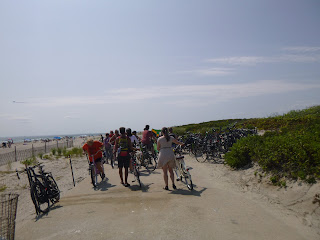
 |

New York is
full of people out there to make their lives into works of art, cyclists careening
across the borough with music and colors, stories and recollections filling the
air.
Sunday was
one such day. I joined a few friends for a ride to the beach at Ft Tilden. Meeting at Grand Army Plaza, my friend Stephen
was there to greet me, as were Julia and Joe and many others.
I asked Stephen
what he’s been up to since our last beach ride two years ago.
Stephen and I
talked about past rides to the beach we’ve been on over the last decade, a few
friends, and his bike tour around Morocco. An extraordinary trip, he arrived in
the airport, assembled his folding bike, and rode sixty miles to Casablanca, navigating
flat tires, poor riding conditions, and countless adventures. Over the next month, he made his way through Morocco
to Tangiers, Rabat, a Spanish town in Northern Africa, back to Europe, via
Gibralter, Spain, exploring islands, Formentera,
Corsica, and back.
Just a bike
ride through Northern Africa, he explained.
One that I want
to take some time soon.
We stopped for
snacks in Sheepshead bay.
Arriving at
Ft Tildon, Ed joined us.
He talked about a few fights he’d had with some Trump
supporters disrupting his tour on the Brooklyn Bridge the other day.
Most of us made it all the way.
At the beach, the tides rolled onto the shores, people
cavorted about without much clothes, and a few of us jumped in for a swim.
Julia Nevárez, an assistant professor and sociology coordinator
at Kean University who rode to from Harlem to Coney Island and back the previous
Friday, told me about how these rides had inspired her writing and research. Her new book, Governing Disaster in Urban Environments: Climate Change Preparation
and Adaption after Hurricane Sandy, grew out of the fossil fuel relief
rides we all took back in 2012 after Hurricane Sandy. Her book is “…
a comprehensive
account of relevant debates, conceptualizations, and practical considerations
for the governance of disaster at multiple scales.” She uses the hurricane to, “analyze the
complex phenomenon of climate change and its effects on flood-prone areas.
Drawing on the notion of the anthropocene and discourse on resiliency, Nevárez
discusses alternative methods of recovery after climate-induced disasters.
Nevárez analyzes international climate agreements and neoliberal policies based
on austerity measures to highlight the need to secure cooperation from the
international community in order to ensure environmental security on a global
scale, including communities of solidarity.”
That’s what we need more of, I thought, communities of
solidarity. What a way to put it.
We talked about the storm that hit Puerto Rico last
year.
I turned in the book as Maria was hitting she told
me. She’s only been back once.
Chatting, we all jumped a wave, riding it back to the
shore swimming back out again.
The water is always a reminder.
Just getting to it, we had to cross a borough. The stories we told took us across the world.
On the way back I rode Flatbush, past
street murals and the Kings Theater, the hot air and feeling of salt water
lingered, the city of Brooklyn opening as it always does.























































No comments:
Post a Comment